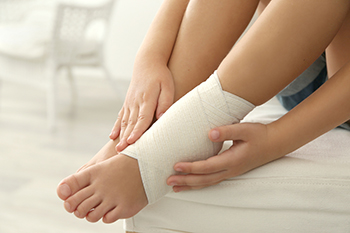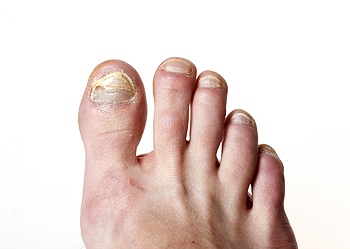Connect With Us
Blog
Items filtered by date: June 2022
Do Your Child's Feet Hurt?
Three Grades of Ankle Sprains

A common form of ankle pain is a sprain. It can be painful and is often difficult to walk. Ankle sprains can happen as a result of twisting the ankle unexpectedly while stepping off a curb, and from changing direction when running on uneven surfaces. Many times the ligament on the outside of the ankle becomes damaged from the twist and this is known as the lateral ligament. The best way to diagnose an ankle sprain is via X-ray. This imaging is an effective method of ruling out a broken ankle. The symptoms that many patients experience include bruising, swelling, and the inability to walk. There are three grades of ankle sprains that people can endure. Grade one is the least painful, and consists of a few tissue fibers that are torn. Considerable pain often accompanies grade two and involves more fibrous tissues torn. Patients are often unable to walk with a grade three sprain, and this is classified as a complete tear of the ligament. Mild relief may come from elevating the affected ankle frequently during the day as this may reduce existing swelling. An ankle sprain can be treated by a podiatrist, and it is important to schedule an appointment as quickly as possible so the correct treatment can begin.
Although ankle sprains are common, they aren’t always minor injuries. If you need your ankle injury looked at, contact Dr. Harry I. Zirna from Lockport Foot Care, PLLC. Dr. Zirna can provide the care you need to keep you pain-free and on your feet.
How Does an Ankle Sprain Occur?
Ankle sprains are the result of a tear in the ligaments within the ankle. These injuries may happen when you make a rapid shifting movement while your foot is planted. A less common way to sprain your ankle is when your ankle rolls inward while your foot turns outward.
What Are the Symptoms?
- Pain at the sight of the tear
- Bruising/Swelling
- Ankle area is tender to touch
- In severe cases, may hear/feel something tear
- Skin discoloration
Preventing a Sprain
- Wearing appropriate shoes for the occasion
- Stretching before exercises and sports
- Knowing your limits
Treatment of a Sprain
In many cases, the RICE method (Rest, Ice, Compression, and Elevate) is used to treat ankle sprains. However, you should see a podiatrist to see which treatment option would work best with your injury. In severe cases, surgery may be required.
It is important to ask your doctor about rehab options after you receive treatment for your injury. Stretching, strength training, and balance exercises may help the ankle heal while also preventing further injury.
If you have any questions, please feel free to contact our offices located in Lockport, NY . We offer the newest diagnostic and treatment technologies for all your foot care needs.
Toenail Problems and Treatments

Toenails protect toes. They are made up of keratin which makes toenails tough and resilient to the daily wear and tears they take. Friction from shoes, physical activity, heat and moisture, and some medical conditions can all affect the toenails. Pain, itching, and discoloration can all be signs of toenail problems. Some of the more common toenail ailments are described here. Toenail fungus is an infection that has gotten into the nail causing it to become jagged or crumble, and can spread to other toenails and surrounding skin. An ingrown toenail occurs when the corner or side of a toenail grows into the skin. This can cause redness and pain and may turn into an infection. Toenail trauma can occur as stubbing a toe, dropping something heavy on the foot, or wearing ill-fitting shoes. These can lead to bruising, separation of the nail from the toe, or injury to the underlying bone. Treatment of toenail issues depends on the cause. If you are experiencing such problems, it is suggested you seek the counsel of a podiatrist for proper diagnosis and treatment.
If left untreated, toenail fungus may spread to other toenails, skin, or even fingernails. If you suspect you have toenail fungus it is important to seek treatment right away. For more information about treatment, contact Dr. Harry I. Zirna of Lockport Foot Care, PLLC. Dr. Zirna can provide the care you need to keep you pain-free and on your feet.
Symptoms
- Warped or oddly shaped nails
- Yellowish nails
- Loose/separated nail
- Buildup of bits and pieces of nail fragments under the nail
- Brittle, broken, thickened nail
Treatment
If self-care strategies and over-the-counter medications does not help your fungus, your podiatrist may give you a prescription drug instead. Even if you find relief from your toenail fungus symptoms, you may experience a repeat infection in the future.
Prevention
In order to prevent getting toenail fungus in the future, you should always make sure to wash your feet with soap and water. After washing, it is important to dry your feet thoroughly especially in between the toes. When trimming your toenails, be sure to trim straight across instead of in a rounded shape. It is crucial not to cover up discolored nails with nail polish because that will prevent your nail from being able to “breathe”.
In some cases, surgical procedure may be needed to remove the toenail fungus. Consult with your podiatrist about the best treatment options for your case of toenail fungus.
If you have any questions, please feel free to contact our offices located in Lockport, NY . We offer the newest diagnostic and treatment technologies for all your foot care needs.
Simple Methods That May Help to Prevent Running Injuries

Many people who enjoy running can experience a small amount of normal discomfort. This may be from strengthening the heart and leg muscles. Additionally, there are people who have persistent pain, and this is something that requires immediate attention. An improper running form or increasing distance and intensity too soon could result in injury. A common foot injury that affects the heel is known as plantar fasciitis, and this can cause difficulty in walking. There are simple methods that can help prevent running injuries. These methods consist of wearing shoes that fit correctly, in addition to avoiding running on uneven surfaces. Many runners can experience a stress fracture which is a hairline fracture. This type of injury is often ignored and can lead to severe pain and discomfort. This condition may be prevented by properly warming up and cooling down before running. An ankle sprain generally requires running to be stopped temporarily so an effective healing process can take place. If you would like more information about how to prevent running injuries, please confer with a podiatrist.
Exercising your feet regularly with the proper foot wear is a great way to prevent injuries. If you have any concerns about your feet, contact Dr. Harry I. Zirna of Lockport Foot Care, PLLC. Dr. Zirna will treat your foot and ankle needs.
How to Prevent Running Injuries
Many common running injuries are caused by overuse and overtraining. When the back of the kneecap starts wearing out and starts causing pain in your knee, this is commonly referred to as runner’s knee. Runner’s knee is a decrease in strength in your quadriceps and can occur if you’re not wearing properly fitted or supporting shoes. To prevent runner’s knee, focusing on hip strengthening is a good idea, as well as strengthening your quads to keep the kneecaps aligned.
What Are Some Causes of Running Injuries?
- One cause of a common running injury is called iliotibial band syndrome.
- Plantar fasciitis is also another common injury.
- Stress fractures can occur from overtraining, lack of calcium, or even your running style.
Best Ways to Prevent Running Injuries
- Wear footwear that fits properly and suits your running needs.
- Running shoes are the only protective gear that runners have to safeguard them from injury.
- Make a training schedule. Adding strengthening exercises as well as regular stretching can help keep you strong and limber and can lessen the possibility of injuries.
- Stretching keeps muscles limber; this will help you gain better flexibility.
If you have any questions please feel free to contact our offices located in Lockport, NY . We offer the newest diagnostic and treatment technologies for all your foot and ankle needs.
Does My Ankle Fracture Need Surgery?

An ankle fracture can happen from suddenly twisting your ankle. This can happen from falling, or possibly from stepping off of a curb unexpectedly. The ankle ligaments may be affected, and surgery may be needed for permanent repair. A surgical benefit can consist of putting the bones back together in proper formation for proper healing. When this is done correctly, treatment can begin by using a walker or cast. During ankle surgery, the broken bones will be exposed on the inner and outside of the ankle. Screws and plates may be used to permanently hold the bones together, and can generally take several weeks to recover. After an appropriate time has passed, it is beneficial to perform specific exercises that can help to strengthen the ankle after surgery. Recovery typically begins with resting the affected ankle on a pillow, and it may help to keep it elevated which can diminish existing swelling. If you have broken your ankle, it is strongly suggested that you contact a podiatrist who can offer you correct treatment options, which may include surgery.
Foot surgery is sometimes necessary to treat a foot ailment. To learn more, contact Dr. Harry I. Zirna of Lockport Foot Care, PLLC. Dr. Zirna will assist you with all of your foot and ankle needs.
When Is Surgery Necessary?
Foot and ankle surgery is generally reserved for cases in which less invasive, conservative procedures have failed to alleviate the problem. Some of the cases in which surgery may be necessary include:
- Removing foot deformities like bunions and bone spurs
- Severe arthritis that has caused bone issues
- Cosmetic reconstruction
What Types of Surgery Are There?
The type of surgery you receive will depend on the nature of the problem you have. Some of the possible surgeries include:
- Bunionectomy for painful bunions
- Surgical fusion for realignment of bones
- Neuropathy decompression surgery to treat nerve damage
Benefits of Surgery
Although surgery is usually a last resort, it can provide more complete pain relief compared to non-surgical methods and may allow you to finally resume full activity.
Surgical techniques have also become increasingly sophisticated. Techniques like endoscopic surgery allow for smaller incisions and faster recovery times.
If you have any questions please feel free to contact our offices located in Lockport, NY . We offer the newest diagnostic and treatment technologies for all your foot and ankle needs.
Blog Archives
- March 2024
- February 2024
- January 2024
- December 2023
- November 2023
- October 2023
- September 2023
- August 2023
- July 2023
- June 2023
- May 2023
- April 2023
- March 2023
- February 2023
- January 2023
- December 2022
- November 2022
- October 2022
- September 2022
- August 2022
- July 2022
- June 2022
- May 2022
- April 2022
- March 2022
- February 2022
- January 2022
- December 2021
- November 2021
- October 2021
- September 2021
- August 2021
- July 2021
- June 2021
- May 2021
- April 2021
- March 2021
- February 2021
- January 2021
- December 2020
- November 2020
- October 2020
- September 2020
- August 2020
- July 2020
- June 2020
- May 2020
- April 2020
- March 2020
- February 2020
- January 2020
- December 2019
- November 2019
- October 2019
- September 2019
- August 2019
- July 2019
- June 2019
- May 2019
- April 2019
- March 2019
- February 2019
- January 2019
- December 2018
- November 2018
- October 2018
- September 2018
- August 2018
- July 2018
- June 2018
- May 2018
- April 2018
- March 2018
- February 2018
- January 2018
- December 2017
- November 2017
- October 2017
- September 2017
- August 2017
- July 2017
- June 2017
- May 2017
- April 2017
- March 2017
- February 2017
- January 2017
- December 2016
- November 2016
- October 2016
- September 2016
- August 2016
- July 2016
- June 2016
- May 2016
- April 2016

